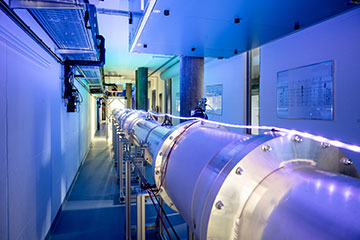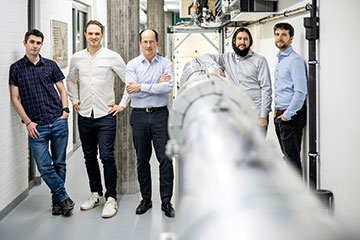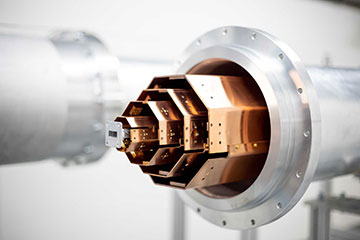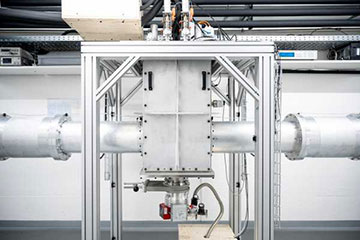Researchers developed a 30-m-long quantum link to carry out Bell’s test. A microwave waveguide that runs inside the vacuum tube, seen in the picture, connects two superconducting circuits, allowing them to become entangled. [Image: ETH Zurich / D. Winkler] [Enlarge image]
A group led by researchers at ETH Zurich, Switzerland, has for the first time robustly demonstrated the principle of nonlocality using entangled superconducting quantum bits, or qubits (Nature, doi: 10.1038/s41586-023-05885-0). The researchers achieved what is known as a loophole-free violation of Bell’s inequality by preparing and measuring pairs of such qubits at either end of a 30-m-long cryogenic link over extremely short timescales. They say that the result paves the way for improved quantum computing and communication based on superconducting technology.
Bell’s inequality
In 1964, British physicist John Stewart Bell proposed the test that now bears his name in response to Albert Einstein’s concept of local hidden variables. Einstein had put forward the idea nearly 30 years earlier with colleagues Boris Podolsky and Nathan Rosen to counter what he regarded as the nonphysical implication of entanglement—the idea that two particles can act as if inextricably linked, no matter how far apart they are. Rather than accept some kind of instantaneous interaction, Einstein reckoned that quantum mechanics must be incomplete and that the particles’ states are predetermined by local variables.
Members of the Quantum Device Laboratory at ETH Zurich who performed the experiment. From left to right: Anatoly Kulikov, Simon Storz, Andreas Wallraff, Josua Schär and Janis Lütolf. [Image: ETH Zurich / D. Winkler] [Enlarge image]
Bell realized that it would be possible in principle to test whether or not entangled particles rely on such variables. The test involves two parties each measuring one half of an entangled pair of particles using one of two possible measurement bases—for example, an electron’s spin along different axes—that they select at random. They then repeat the process many times over and compare their results. If the experimenters observe a strict limit on the correlation between those results, they would show that locality holds. If the correlation instead exceeds, or “violates,” that limit (expressed as a mathematical inequality), the researchers would instead prove the validity of quantum mechanics.
Via a series of increasingly sophisticated experiments carried out over the last 50 years, scientists have shown that the inequality is indeed violated and that therefore local causality does not apply to entangled quantum particles. The results are potentially susceptible to a number of loopholes—experimental limitations that would leave room for local variables—but since 2015, several groups have reported being able to close all major loopholes simultaneously, using qubits made from diamond defects, optical photons and trapped atoms.
Experimental process
In the latest work, Andreas Wallraff and Simon Storz at ETH Zurich together with colleagues in Switzerland and around the world, extend this feat to superconducting qubits. Their setup, housed in a long underground hallway at ETH Zurich, involves two superconducting circuits connected by a microwave waveguide that runs along the inside of a 30-m-long vacuum tube. Both the circuits and waveguide are cooled to just a few tens of millikelvins above absolute zero.
A view inside the 30-m-long quantum connection. An aluminum waveguide at the center connects two quantum circuits. Several layers of copper shielding provide protection from thermal radiation. [Image: ETH Zurich / D. Winkler] [Enlarge image]
The experiment’s first step is to entangle one of the circuits with a microwave photon and then send that photon to the other circuit, causing the two circuits—each a qubit—to become entangled with one another. Both qubits are then subjected to a polarization measurement in one of two bases, with the choice of basis determined by a random number generator located next to the respective qubit. The measurement reveals whether the qubit is in its ground or excited state (represented as +1 and –1, respectively).
That process—entanglement, basis choice and measurement—is repeated many times in quick succession, with the outcome in each case being a product of the two qubit values. The researchers calculated the averages of the product of each of the four possible outcomes, then added them together in such a way that if the system could be described by the local hidden variables, the sum (S) would not exceed 2. But if quantum mechanics held sway, S would instead be between 2 and 2√2 (about 2.83).
One of the main challenges in performing the experiment was closing what is known as the locality loophole. In other words, the researchers had to carry out the measurement process (minus the entanglement) more quickly than light could travel between the two qubits to prevent the qubits from signaling one another. They did this by reducing the time it takes to read out measurements to just 50 ns, leading to a total measurement time of 107 ns on average (when also accounting for random number generation and basis rotation). The reduction in readout time cut the required qubit separation to about 30 m, and the researchers, after years of development, were able to build a low-loss cryogenic waveguide of this length.
The researchers have developed their own cryostat to cool the 30-m-long quantum connection efficiently. The cryostat is installed in the middle of the quantum link. [Image: ETH Zurich / D. Winkler] [Enlarge image]
Extraordinarily small probability
Carrying out more than a million individual trials, Wallraff and colleagues recorded an average S of 2.0747 ± 0.0033. This, they say, implies an extraordinarily small probability that only local interactions were responsible for the correlations they observed—just 1 in 10108.
The researchers believe they could push S above 2.4 by reducing the waveguide’s photon loss (which distorts the ratio of ground- to excited-state observations). Combined with even higher repetition rates—the current experiment having already achieved 12,500 trials a second—they argue that their superconducting technology would be suitable for device-independent quantum information processing, including both quantum key distribution and computing.
What’s more, the researchers say their ability to house superconducting circuits within cryogenic systems spanning tens of meters suggests the possibility of scaling up quantum processing. “Interconnected cryogenic systems may indicate a pathway towards realizing larger scale quantum computing systems using quantum microwave local area networks,” they write, “for example, within a quantum computing center.”




